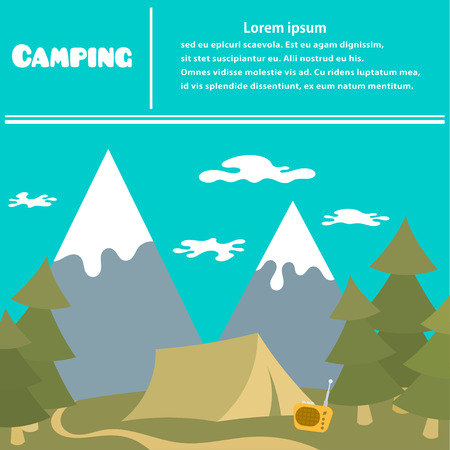1. What Are Topographic Maps?
When youre heading out for a camping trip, especially in remote or unfamiliar areas, having the right kind of map can make all the difference. That’s where topographic maps come in. Unlike your everyday road maps or digital GPS apps, topographic maps give you a detailed look at the landscape — not just where things are, but how the land actually looks and changes in elevation.
How Are Topographic Maps Different?
Topographic maps are unique because they use contour lines to show elevation changes. These lines help you understand if the terrain is flat, hilly, or mountainous. The closer together the lines are, the steeper the slope. Other maps like street maps or political maps don’t include this kind of detail — they focus on roads, cities, or boundaries instead of natural land features.
Comparison of Map Types
| Type of Map | Main Features | Best For |
|---|---|---|
| Topographic Map | Contour lines, elevation data, natural features | Hiking, camping, outdoor navigation |
| Road Map | Highways, roads, towns | Driving directions and urban travel |
| Political Map | Borders, cities, countries | Understanding geographical boundaries |
| Satellite Map | Real-world imagery from above | Visual reference and general overview |
Why Topographic Maps Matter for Campers
If youre planning a camping adventure off the beaten path — say in a national forest or backcountry area — knowing the lay of the land is essential. A topographic map helps you:
- Avoid steep climbs by identifying elevation changes ahead of time
- Locate water sources like rivers and lakes
- Find flat ground suitable for setting up camp
- Navigate trails that may not be marked on standard maps or GPS devices
In short, topographic maps are more than just tools; they’re your guide to understanding and navigating nature safely and confidently.
2. Understanding Contour Lines and Elevation
When youre heading out on a camping trip into the backcountry, knowing how to read a topographic map can make all the difference. One of the key elements of these maps is contour lines—they tell you everything about the shape and elevation of the land. Once you understand how to interpret them, you’ll be able to spot hills, valleys, ridges, and flat areas with just a glance.
What Are Contour Lines?
Contour lines are thin, curving lines that connect points of equal elevation on a map. Think of them as slices through the terrain at regular vertical intervals. If you walked along a single contour line in real life, youd stay at exactly the same elevation the entire time.
How Elevation Intervals Work
The space between each contour line is called the “contour interval.” This tells you how much elevation change happens from one line to the next. The interval is usually listed in the map legend.
Common Elevation Intervals
| Map Scale | Typical Contour Interval | Best Used For |
|---|---|---|
| 1:24,000 (7.5-minute USGS topo maps) | 10 or 20 feet | Backpacking & hiking |
| 1:100,000 | 50 feet | Planning routes over large areas |
| 1:250,000 | 100 feet or more | Long-distance travel planning |
Reading Terrain from Contour Lines
Slope Steepness
The spacing between contour lines tells you how steep or gentle a slope is:
- Close together: Steep slope (think cliffs or mountainsides)
- Far apart: Gentle slope (like rolling hills or meadows)
Identifying Land Features
| Feature | Description on Map |
|---|---|
| Hilltop or summit | Concentric closed loops with smaller loops inside larger ones; center is highest point |
| Saddle or pass | An hourglass-shaped dip between two high points; useful for route planning through mountains |
| Ridge | Narrow elevated area; contour lines form elongated loops pointing downhill |
| Valley or drainage | “V”-shaped contours pointing uphill; often indicates presence of a stream or riverbed |
Estimating Elevation Gain on Your Route
You can estimate how much climbing youll do by counting how many contour lines your trail crosses and multiplying by the interval. For example, if your trail crosses 10 contour lines with a 20-foot interval, thats a 200-foot elevation gain.
Quick Tip:
If youre using a GPS app with topographic layers (like Gaia GPS or AllTrails), you can cross-reference digital data with paper maps for more accuracy.
Understanding these basics will help you choose safer routes, avoid exhausting climbs, and find better campsites—especially when venturing off the beaten path.

3. How to Read a Topographic Map
Understanding how to read a topographic (topo) map can open up a whole new level of confidence and safety for your camping adventures. Whether youre using a USGS map or a custom-made topo, knowing how to interpret the key elements will help you navigate terrain like a pro. Here’s a simple step-by-step guide to reading these maps effectively.
Step 1: Understand the Scale
The scale tells you how much real-world distance is represented by the map. Common USGS topo maps use a 1:24,000 scale, which means one inch on the map equals 24,000 inches (or 2,000 feet) on the ground. Some maps may use different scales depending on their purpose. A larger ratio (like 1:100,000) covers more area with less detail, while a smaller ratio (like 1:24,000) offers more detail but covers less area.
Common Topo Map Scales
| Scale | Real World Distance | Best For |
|---|---|---|
| 1:24,000 | 1 inch = 2,000 feet | Hiking and Camping |
| 1:62,500 | 1 inch = ~1 mile | Backpacking Over Larger Areas |
| 1:100,000 | 1 inch = ~1.6 miles | Regional Planning |
Step 2: Decode the Symbols
Topo maps are filled with symbols that represent natural and man-made features like trails, rivers, campsites, and buildings. These symbols are standardized on USGS maps but may vary slightly on custom maps.
Common Map Symbols
| Symbol | Description |
|---|---|
| ■ | Building or Structure |
| ▲ | Campsite or Shelter |
| ○ | Water Source (Spring or Well) |
| – – – – | Trail or Footpath |
| wavy line (~) | Stream or River |
| dotted line (….) | Unimproved Road or Off-road Trail |
Step 3: Use the Legend as Your Key
The legend is usually located in a corner of the map and functions like a dictionary for all the symbols and colors used. It explains what each symbol represents and provides additional information like contour intervals and magnetic declination.
Step 4: Understand Contour Lines and Elevation
Contour lines show elevation changes and help you visualize the shape of the land. Each line connects points of equal elevation. The closer the lines are to each other, the steeper the slope; lines spaced farther apart indicate flatter terrain.
Contour Line Basics
- Index Lines: Thicker lines labeled with elevation numbers (e.g., 5,000 ft).
- Intermediate Lines: Thinner lines between index lines, usually in intervals of 10 or 20 feet.
- Circular Lines: Closed loops typically represent hills; closed loops with hash marks point downhill into depressions.
Step 5: Navigate Using Grid Coordinates
Most topo maps have grid systems—latitude/longitude or UTM coordinates—that help you pinpoint your exact location. These grids are useful when using GPS devices or when coordinating with others.
Main Coordinate Systems Used on US Maps
| System | Description |
|---|---|
| Latitude/Longitude | A global coordinate system using degrees (°), minutes (), seconds (“). Great for GPS devices. |
| UTM (Universal Transverse Mercator) | A metric-based grid that divides the world into zones for detailed local navigation. |
| MGRS (Military Grid Reference System) | A military variation of UTM used for precise location referencing. |
Quick Tips for First-Time Users:
- Always orient your map with north at the top using a compass.
- If hiking in unfamiliar terrain, mark your route ahead of time and note elevation changes.
- Keeps maps dry using waterproof cases or laminated versions.
- If unsure about symbols or coordinates, refer back to your legend—it’s there to help!
No matter where your campsite lies—on a mountain ridge, deep in a forest valley, or beside a remote lake—knowing how to read a topo map ensures you can get there safely and confidently.
4. Using Topo Maps for Trip Planning
Planning a camping or hiking trip with a topographic map might seem intimidating at first, but once you understand the basics, it becomes one of the most useful tools in your outdoor toolkit. Whether youre heading into the backcountry or exploring a local state park, topo maps help you visualize the terrain and prepare for what’s ahead.
Why Use a Topo Map?
A topographic map shows you more than just trails—it reveals elevation changes, water sources, vegetation, and potential obstacles. These details are critical when choosing a safe and enjoyable route for your camping adventure.
Key Features to Look For
| Feature | What It Tells You |
|---|---|
| Campsites | Look for flat areas near water but away from steep slopes or flood zones. |
| Water Sources | Streams, rivers, and lakes are usually marked in blue; check their proximity to your route. |
| Elevation Lines | Tightly spaced lines mean steep terrain; wide spaces indicate flatter ground. |
| Trail Markings | Dashed or solid lines often represent maintained trails or paths. |
| Hazards | Cliffs, avalanche zones, and dense forests can be identified by their contour patterns and symbols. |
Tips for Planning Your Route
#1: Choose Your Campsite Wisely
Select a spot that’s elevated enough to avoid water runoff but close to a fresh water source. Look for clearings or flat areas on the map where contour lines are widely spaced.
#2: Estimate Hiking Difficulty
The steeper the slope, the more challenging the hike. Use contour intervals to judge how much elevation gain youll face. A good rule of thumb is that 10 contour lines per mile suggest a moderate climb.
#3: Identify Water Access Points
You’ll need water for drinking, cooking, and cleaning. Plan your route so youre never too far from a stream or lake—but make sure to treat all natural water before using it.
#4: Avoid Potential Hazards
If you see tightly packed contour lines forming sharp ridges or drop-offs, that indicates cliffs or very steep areas. Avoid planning routes across these unless youre experienced in technical hiking or climbing.
#5: Consider Sunlight and Wind Exposure
The direction of slopes (north-facing vs south-facing) can affect how warm or windy your campsite will be. South-facing slopes get more sun and tend to be warmer and drier—great for early spring or late fall trips.
A Sample Planning Checklist Using a Topo Map
| Task | Status Check |
|---|---|
| Select route based on skill level | ☑ |
| ID campsites with flat terrain | ☑ |
| ID nearby water sources | ☑ |
| Avoid steep or hazardous sections | ☑ |
| Create backup plans for weather changes | ☑ |
5. Topographic Maps in the Digital Age
Gone are the days when you had to rely solely on bulky paper maps and a compass to navigate the great outdoors. Today’s campers have access to powerful digital tools that combine detailed topographic data, GPS tracking, and offline functionality—all in the palm of your hand. Whether you’re planning a backcountry hike or setting up camp off the grid, apps like Gaia GPS and AllTrails have revolutionized how we explore nature.
Gaia GPS
Gaia GPS is a favorite among serious outdoor enthusiasts for good reason. It offers high-resolution topographic maps that can be downloaded for offline use—perfect for remote areas without cell service. With real-time GPS tracking, you can see exactly where you are on the map, making it easier to stay on course. The app also allows users to mark waypoints, measure distances, and record routes.
Key Features of Gaia GPS:
| Feature | Description |
|---|---|
| Offline Maps | Download topographic maps to use without internet access |
| GPS Tracking | See your live location on the map even without cell signal |
| Map Overlays | Customize with layers like public land boundaries and weather |
| Route Planning | Create and save hiking or camping routes before your trip |
AllTrails
AllTrails is widely popular among casual hikers and weekend campers. It offers an extensive database of user-submitted trail reviews and photos, which makes it easy to find new places to explore. While its topographic mapping features aren’t as advanced as Gaia GPS, they’re more than enough for most recreational users. The Pro version allows for offline map downloads and includes real-time overlays like air quality and weather conditions.
Key Features of AllTrails:
| Feature | Description |
|---|---|
| Trail Database | Search thousands of trails with user reviews and ratings |
| Offline Access (Pro) | Download trails and maps for use without connectivity |
| GPS Navigation | Track your route in real time with built-in GPS tools |
| User Sharing | Upload photos, leave tips, and share completed hikes |
Choosing the Right App for Your Camping Style
If youre heading deep into backcountry terrain where navigation accuracy is critical, Gaia GPS is likely your best bet. For family-friendly hikes or car camping trips where finding a new trail is part of the fun, AllTrails provides plenty of inspiration and ease of use. Both apps offer subscription plans that unlock premium features, but even their free versions are handy tools for getting started.
Quick Comparison:
| App | Best For | Offline Maps | Live GPS Tracking |
|---|---|---|---|
| Gaia GPS | Advanced navigation & backcountry camping | Yes (Free & Premium) | Yes |
| AllTrails | User-friendly trail discovery & casual campers | Yes (Pro Only) | Yes |
The rise of digital topographic tools has made it easier than ever to plan safe, exciting camping adventures. By understanding how these apps work and what they offer, you’ll be better prepared no matter where your next trip takes you.


